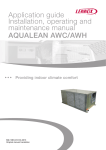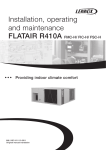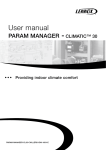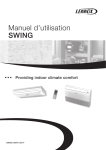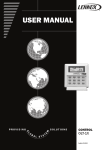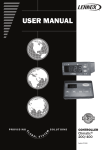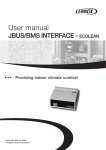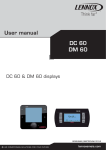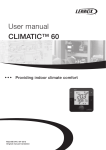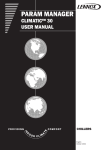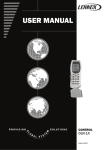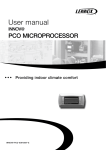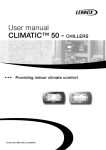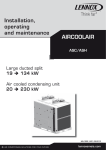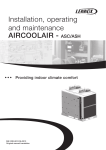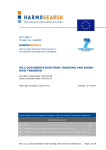Download AQUALEAN AWC/AWH Application guide Installation, operating and
Transcript
Application guide Installation, operating and maintenance manual AQUALEAN AWC/AWH Providing indoor climate comfort MIL118E-0413 08-2013 Original manual translation WARNING: Read this manual before installation, reparation o maintenance works. TABLE OF CONTENTS POINTS TO BEAR IN MIND PAGE 2 DATA PAGE FOR COMMISSIONING UNIT PAGE 3 1.- GENERAL CHARACTERISTICS PAGE 4 5 6 6 7 7 8 9-12 13 14 15 1.1.- PRODUCT RANGE 1.2.- GENERAL DESCRIPTION 1.3.- PHYSICAL DATA 1.4.- ELECTRICAL SPECIFICATIONS 1.5.- ELECTRICAL CONNECTIONS 1.6.- OPERATING LIMITS 1.7.- FAN SPECIFICATIONS 1.8.- CAPACITY TABLES 1.9.- CORRECTION FACTORS 1.10.- DIMENSIONS 1.11.- OPTIONS 2.- INSTALLATION 2.1.- PRE - INSTALLATION 2.2.- UNIT INSTALLATION PAGE 17 18-19 3.- COMMISSIONING AND OPERATION 3.1.- PRELIMINARY CHECKS BEFORE FIRST INSTALLATION 3.2.- PRELIMINARY CHECKS AT FIRST INSTALLATION 4.- MAINTENANCE 4.1.- PREVENTIVE MAINTENANCE 4.2.- CORRECTIVE MAINTENANCE PAGE 20 20-21 PAGE 22 22 Lennox have been providing environmental solutions since 1895, our AQUALEAN (AWC/AWH) range continues to meet the standards that have made LENNOX a household name. Flexible design solutions to meet your needs and uncompromising attention to detail. Engineered to last, simple to maintain and Quality that comes as standard. For information on local contacts at www.lennoxeurope.com. All the technical and technological information contained in this manual, including any drawing and technical descriptions provided by us, remain the property of Lennox and must not be used (except in the operation of this product), reproduced, issued to or made available to third parties without the prior written agreement of Lennox. 1 POINTS TO BEAR IN MIND DANGER AND WARNING SIGNS Abrasive surfaces Low temperatures High temperatures Risk of injury by moving objects Electrical voltage Risk of injury by rotating objects ELECTRICAL CONNECTIONS Make sure to switch off the power before installing, repairing or carrying out maintenance on the unit, in order to prevent serious electrical injury. Keep local and national legislation in mind when installing the unit. ATTENTION - WARNING Electrical shock hazard can cause injury or death. Before attempting to perform any service or maintenance on the unit, turn OFF the electrical power. The air filter cleaning operations do not require technical service; however when an electrical or mechanical operation is required call an Engineer. FILTER CLEANING Check the air filter and make sure it is not blocked with dust or dirt If the filter is dirty, wash it in a bowl neutral soap and water, drying it in the shade before inserting it in the unit. Standard Guidelines to Lennox equipment All technical data contained in these operating instructions, including the diagrams and technical description remains the property of Lennox and may not be used (except for the purpose of familiarizing the user with the equipment), reproduced, photocopied, transferred or transmitted to third parties without prior written authorization from Lennox. The data published in the operating instructions is based on the latest information available. We reserve the right to make modifications without notice. We reserve the right to modify our products without notice without obligation to modify previously supplied goods. These operating instructions contain useful and important information for the smooth operation and maintenance of your equipment. The instructions also include guidelines on how to avoid accidents and serious damage before commissioning the equipment and during its operation and how to ensure smooth and fault-free operation. Read the operating instructions carefully before starting the equipment, familiarize yourself with the equipment and handling of the installation and carefully follow the instructions. It is very important to be properly trained in handling the equipment. These operating instructions must be kept in a safe place near the equipment. Like most equipment, the unit requires regular maintenance. This section concerns maintenance and management personnel. If you have any queries or would like to receive further information on any aspect relating to your equipment, do not hesitate to contact us. 2 DATA PAGE FOR UNIT COMMISSIONING UNIT: SERIAL Nr: CONTROL PANEL IDENTIFICATION CODE: INSTALLATION ADDRESS: INSTALLER: INSTALLER TEL: INSTALLER ADDRESS: DATE OF COMMISSIONING: CHECKS: SUPPLY VOLTAGE: RATED VOLTAGE OF THE UNIT: YES NO UNIT ON SHOCK ABSORBERS DRAINAGE WITH TRAP MAIN POWER SUPPLY CONNECTION CONTROL PANEL CONNECTION COMPRESSOR OIL LEVEL INDICATOR DATA INPUT: COOLING CYCLE HEATING CYCLE Air intake temperature to the indoor coil: Air intake temperature to the indoor coil: High pressure: High pressure: Low pressure: Low pressure: ELECTRIC POWER CONSUMPTION (Amps) Compressor 1 Indoor fan Compressor Indoor fan Options installed: Comments: 3 1.- GENERAL CHARACTERISTICS 1.1.- PRODUCT RANGE A W C 007 S S: 1 Circuit C: Cooling only H: Heat pump Unit AQUALEAN N M 1 M Type of refrigerant M: R-410A --- Approximate cooling capacity in kW T: 230V/1/50 M: 400V/3/50 Number of revision COOLING ONLY UNITS V / Ph / 50 Hz NOMINAL CAPACITY kW NOMINAL POWER INPUT kW COOLING COOLING AWC 007 230 V - 1Ph 6.75 1.69 AWC 008 230 V - 1Ph 8 2.05 AWC 010 230 V - 1Ph 10.2 2.55 11.2 2.8 14.5 3.37 17 4.15 19 4.75 NOMINAL CAPACITY kW NOMINAL POWER INPUT kW MODEL AWC 012 AWC 015 AWC 018 AWC 020 230 V - 1Ph 230 V - 3Ph 400 V - 3Ph 230 V - 3Ph 400 V - 3Ph 230 V - 3Ph 400V - 3Ph 230 V - 3Ph 400V - 3Ph HEAT PUMP UNITS MODEL V / Ph / 50 Hz AWH 007 COOLING HEATING COOLING HEATING 230 V - 1Ph 6.75 8 1.69 2.1 AWH 008 230 V - 1Ph 8 9.5 2.05 2.5 AWH 010 230 V - 1Ph 10.2 12.3 2.55 3.2 11.2 13.5 2.8 3.6 AWH 012 230 V - 1Ph 400 V - 3Ph AWH 015 400 V - 3Ph 14.5 17 3.37 4.6 AWH 018 400V - 3Ph 17 19.5 4.15 5.1 AWHW 020 400V - 3Ph 19 22 4.75 6 4 1.- GENERAL CHARACTERISTICS 1.2.-GENERAL DESCRIPTION The air conditioner, horizontal compact, water condensed type AQUALEAN, are specially designed for small and average installation, office, house, etc. On standard version the unit cleans, filters, cools and dehumidifies the air (AWC), and in addition heats if it is heat pump unit (AWH). You are able to incorporate option elements such as electrical heater. CABINET The cabinet is made of galvanised steel with compact dimensions and features allow the unit to be positioned in almost any location. Internally the unit incorporates thermal acoustic insulation. 25mm A2,s1,d0 / M0 insulation in air section Thermal/acoustic insulation in compressor area AIR FILTER A polypropylene washable air filter is incorporated in the unit it is accessible for maintenance operations. ELECTRIC CIRCUIT The electrical box includes all the components and terminal blocks needed for the installation. It includes a printed board and reversible working mode in heat pump units. In addition alarm, ON/OFF remote and dry contact for water pump are available too. AIR EXCHANGER Made of copper tubing with aluminum swirl fins, they are designed and specially dimensioned to obtain the maximum output. REMOTE CONTROL CLIMATIC™ 60 microprocessor based control is providing the following functions : - 7 scheduling time zones per day over 7 days to allow energy consumption and sound level management according to the building use and environmental constraints.-Airflow regulation to adapt unit operation to the installation requirements. - Master/slave or cascade control of 2, up to 10 units operating in parallel with operating time equalization and automatic change-over in case of a unit fault. COMPRESOR Scroll compressor for all models, all of them with internal thermic protection. It is mounted on vibration-absorbent blocks both on the inside and outside, statically and dynamically balanced. FAN The units include a centrifugal fan motor with 3 fan speeds management. WATER EXCHANGER The unit includes an exchanger plate, compact and resistant made on stainless steel, specially selected for this type of unit. COOLING/HEATING CIRCUIT Made of welded dehumidifying copper tube with access connections. Cooling only units (AWC): They include dehydrator filter, liquid recipient, and electronic expansion valve, high pressure switch and low pressure transducer. Heat pump units (AWH): They include as expansion system an electronic expansion valve, high pressure switch and low pressure transducer. They includes a 4 ways valve and liquid receiver. To work properly in heating mode, the unit includes check valve, restrictor and filter drier. OPTIONS The unit leaves the factory with R410A refrigerant. WATER CIRCUIT It includes water threaded connections H-G. 5 • Electrical heater mounted on fan discharge. • Flow switch • Water filter. • Main switch • Compressor acoustic jacket • Three phase protection (three phase units). • Low water loop temperature • Water diferential pressure switch • MODBUS / BACNET / LONWORKS Communications • DS60 Service display • Airflow configuration 1.- GENERAL CHARACTERISTICS 1.3.- PHYSICAL DATA AWC 007 AWC 008 AWC 010 AWC 012 AWC 015 AWC 018 AWC 020 AWH 007 AWH 008 AWH 010 AWH 012 AWH 015 AWH 018 AWH 020 UNIT MODEL Total cooling capacity kW (*) 6.75 8.00 10.20 11.20 14.50 17.00 19.00 Total heating capacity kW (**) 8.00 9.50 12.30 13.50 17.00 19.50 22.00 Nominal absorbed power Cooling kW (*) 1.69 2.05 2.55 2.80 3.37 4.15 4.75 Nominal absorbed power Heating kW (**) 2.10 2.50 3.20 3.60 4.60 5.10 6.00 m3/h 1430/1010 1620/1250 2100/1550 2200/1620 2610/1850 3100/2060 3500/2450 Max. available static pressure(1) Pa 150 125 150 150 150 150 150 Nominal water flow l/h 1450 1730 2190 2410 3070 3640 4090 Water pressure drop kPa 25 30 40 48 40 45 55 Net weight Kg 69/71 70/72 109/111 111/113 113/116 148/151 148/151 dB(A) 49/51 50/52 48/51 49/51 49/53 46/51 47/54 Height mm 441 441 491 491 491 531 531 Width mm 886 886 1180 1180 1180 1600 1600 Depth mm 492 492 623 623 623 703 703 1” G 1” G 1” G 1” G 1” G 1” G 1” G Air flow (max./min.) Cooling / heating Sound pressure level (LP) (2) Low/High speed Dimensions Hydraulic connections (*) Exchanger air inlet temperature: 27ºC DB / 19ºC WB. Exchanger water inlet temperature: 30ºC. (**) Exchanger air inlet temperature: 20ºC DB. Exchanger water inlet temperature: 20ºC. (1) With admissible minimum air flow. (2) Sound pressure level has been tested at a distance of 2 m from the unit, with duct in aspiration and air discharge, normal absorption in accordance with room size and unit capacity. DB.- Dry bulb temperature WB.- Wet bulb temperature 1.4.- ELECTRICAL SPECIFICATIONS AWC 007 AWC 008 AWC 010 AWC 012 AWC 015 AWC 018 AWC 020 AWH 007 AWH 008 AWH 010 AWH 012 AWH 015 AWH 018 AWH 020 UNIT MODEL 1 Ph VOLTAGE MAXIMUM ABSORBED POWER MAXIMUM RUNNING CURRENT 230V/1Ph - - - 3 Ph - - - Compressor kW 2.57 3.15 3.82 4.62 / 4.31 5.46 5.93 7.26 Indoor fan kW 0.147 0.147 0.250 0.250 0.250 0.315 0.315 TOTAL kW 2.72 3.30 4.07 4.87 / 4.56 5.71 6.25 7.58 Maximum running current A 14.4 17.6 24.6 28.6 / 10.6 12.9 14.7 17.9 Starting current A 61.6 68.6 100.6 130.6 / 45.6 54.1 66.9 77.9 6 400V 3Ph 1.- GENERAL CHARACTERISTICS 1.5.- ELECTRICAL CONNECTIONS 3 1 - Power supply 2 - Power supply with electrical heater 3 - Connection control EH E.Box 1 2 FOR ELECTRICAL CONNECTION REFER TO WIRING DIAGRAM IN THE UNIT. Nº DE CABLES X SECCION MODEL VOLTA 50Hz 1 2 AWC/H 007 230V / 1Ph 3 X 2,5mm² 3 X 10mm² AWC/H 008 230V / 1Ph 3 X 2,5mm² 3 X 10mm² AWC/H 010 230V / 1Ph 3 X 6mm² 3 X 16mm² 230V / 1Ph 3 X 6mm² 3 X 16mm² 400V / 3Ph+N 5 X 2,5mm² 5 X 6mm² AWC/H 015 400V / 3Ph+N 5 X 2,5mm² 5 X 6mm² AWC/H 018 400V / 3Ph+N 5 X 4mm² 5 X 10mm² AWC/H 020 400V / 3Ph+N 5 X 4mm² 5 X 10mm² AWC/H 012 3 5 X 1 mm² Apantallado Local and national legislation has to be taken into account when the unit will be installed. INSTALLATION GUIDE FOR CONTROL CABLE (TO AVOID INTERFERENCES): • Use the screened 15 m cable supplied with terminal (3 wires + screen). • Wire the cable separated from electrical power wiring by a physical distance of 500 mm. • Wire the cable separated from halogen lamps/fluorescent tube lighting... by a phyisical distance of 500 mm. • Wire the cable separated from radio frequency sources such as radio transmitter... at least 500 mm. NEVER WIND THE REMAINING CABLE AROUND, CUT THE CABLE BY THE TERMINAL END. 1.6.- OPERATING LIMITS Water inlet temperature COOLING MODE Water inlet temperature HEATING MODE 45ºC 25ºC 22ºC 15ºC 10C 21/15ºC 32/23ºC 17ºC Air inlet temperature into indoor section D.B/W.B 20ºC 24ºC Air inlet temperature into indoor section D.B/W.B WB.- Wet bulb temperature DB.- Dry bulb temperature 7 1.- GENERAL CHARACTERISTICS 1.7.- FAN SPECIFICATIONS AWH 007 AIR FLOW m3/h 37 50 75 100 HIGH SPEED 1430 1400 1375 1315 MEDIUM SPEED 1300 1250 1240 1185 LOW SPEED 1170 1140 1125 1070 AWH 008 AIR FLOW m3/h 1065 1050 - 1010 - - AVAILABLE STATIC PRESSURE Pa. 37 50 75 100 125 150 1550 1475 1395 1300 - MEDIUM SPEED 1550 1500 1480 1420 1350 1260 - LOW SPEED 1430 1400 1375 1315 1250 - - 25 37 50 75 100 125 150 HIGH SPEED 2100 2075 2050 1990 1925 1850 1750 MEDIUM SPEED 1915 1900 1885 1830 1790 1700 - LOW SPEED 1685 1680 1675 1640 1600 1550 - 25 37 50 75 100 125 150 HIGH SPEED 2200 2180 2150 2025 1925 1800 1550 MEDIUM SPEED 2025 2000 1985 1875 1775 1650 - LOW SPEED 1825 1815 1780 1700 1620 - - 25 37 50 75 100 125 150 HIGH SPEED 2610 2550 2480 2350 2185 2000 1750 MEDIUM SPEED 2575 2560 2450 2300 2150 1970 1730 LOW SPEED 2350 2300 2250 2150 2025 1850 - 25 37 50 75 100 125 150 HIGH SPEED 3100 2980 2960 2815 2650 2450 2210 MEDIUM SPEED 2910 2850 2800 2610 2450 2300 2100 LOW SPEED 2615 2550 2500 2375 2230 2060 - 25 37 50 75 100 125 150 HIGH SPEED 3500 3400 3300 3100 2900 2600 2300 MEDIUM SPEED 3250 3200 3100 2940 2750 2550 2300 LOW SPEED 3100 3030 3960 2815 2650 2450 - AWH 020 AIR FLOW m3/h 1165 1125 1585 AWH 018 AIR FLOW m3/h 1245 25 AWH 015 AIR FLOW m3/h 150 1620 AWH 012 AIR FLOW m3/h 125 HIGH SPEED AWH 010 AIR FLOW m3/h AVAILABLE STATIC PRESSURE Pa. 25 AVAILABLE STATIC PRESSURE Pa. AVAILABLE STATIC PRESSURE Pa. AVAILABLE STATIC PRESSURE Pa. AVAILABLE STATIC PRESSURE Pa. AVAILABLE STATIC PRESSURE Pa. 8 1.- GENERAL CHARACTERISTICS 1.8.- CAPACITY TABLES AWC/AWH 007 Nominal air flow 1.250 m3/h Water inlet temperature ºC 10 15 20 25 30 35 40 Water pressure drop kPa Water flow l/h Minimum Nominal Maximum Minimum Nominal Maximum Minimum Nominal Maximum Minimum Nominal Maximum Minimum Nominal Maximum Minimum Nominal Maximum Minimum Nominal Maximum 1010 1450 2070 1010 1450 2070 1010 1450 2070 1010 1450 2070 1010 1450 2070 1010 1450 2070 1010 1450 2070 15 25 40 15 25 40 15 25 40 15 25 40 15 25 40 15 25 40 15 25 40 COOLING CAPACITY AWC/AWH Total capacity EER Sensible/Total kW ------7,43 7,51 7,55 7,20 7,28 7,33 6,94 7,03 7,08 6,66 6,75 6,81 6,36 6,45 6,51 6,04 6,13 6,20 ------6,27 6,56 6,83 5,31 5,57 5,80 4,49 4,72 4,91 3,80 4,00 4,14 3,25 3,41 3,52 2,82 2,96 3,02 HEATING CAPACITY AWH Total capacity Total power kW input kW ------0,66 0,66 0,66 0,67 0,66 0,66 0,68 0,67 0,67 0,69 0,68 0,68 0,70 0,69 0,69 0,71 0,71 0,70 6,28 6,49 6,62 7,03 7,24 7,40 7,77 8,00 8,17 8,51 8,75 8,95 ------------------- 3,43 3,48 3,52 3,62 3,67 3,70 3,76 3,80 3,82 3,85 3,88 3,89 ------------------- AWC/AWH 008 Nominal air flow 1.500 m3/h Water inlet temperature ºC 10 15 20 25 30 35 40 Water pressure drop kPa Water flow l/h Minimum Nominal Maximum Minimum Nominal Maximum Minimum Nominal Maximum Minimum Nominal Maximum Minimum Nominal Maximum Minimum Nominal Maximum Minimum Nominal Maximum 1210 1730 2470 1210 1730 2470 1210 1730 2470 1210 1730 2470 1210 1730 2470 1210 1730 2470 1210 1730 2470 20 30 50 20 30 50 20 30 50 20 30 50 20 30 50 20 30 50 20 30 50 COOLING CAPACITY AWC/AWH Total capacity EER Sensible/Total kW ------8,85 8,95 9,01 8,55 8,65 8,71 8,23 8,33 8,40 7,90 8,00 8,07 7,55 7,65 7,73 7,18 7,29 7,37 ------5,86 6,09 6,30 5,05 5,26 5,45 4,34 4,54 4,69 3,73 3,90 4,03 3,21 3,36 3,46 2,78 2,91 2,98 HEATING CAPACITY AWH Total capacity Total power kW input kW ------0,66 0,65 0,65 0,66 0,66 0,66 0,67 0,67 0,67 0,68 0,68 0,68 0,69 0,69 0,69 0,70 0,70 0,70 Nominal capacity conditions: Exchanger air inlet temperature: 27ºC DB/19ºC WB for cooling y 20ºC WB for heating mode. (DW:dry bulb WB:wet bulb) For another working conditions use correction factor tables. 9 7,56 7,79 7,93 8,41 8,65 8,81 9,25 9,50 9,68 10,08 10,34 10,55 ------------------- 3,43 3,47 3,51 3,59 3,63 3,66 3,72 3,75 3,77 3,79 3,82 3,83 ------------------- 1.- GENERAL CHARACTERISTICS 1.8.- CAPACITY TABLES AWC/AWH 010 Nominal air flow 1.900 m3/h Water inlet temperature ºC 10 15 20 25 30 35 40 Water pressure drop kPa Water flow l/h Minimum Nominal Maximum Minimum Nominal Maximum Minimum Nominal Maximum Minimum Nominal Maximum Minimum Nominal Maximum Minimum Nominal Maximum Minimum Nominal Maximum 1530 2190 3130 1530 2190 3130 1530 2190 3130 1530 2190 3130 1530 2190 3130 1530 2190 3130 1530 2190 3130 25 40 65 25 40 65 25 40 65 25 40 65 25 40 65 25 40 65 25 40 65 COOLING CAPACITY AWC/AWH Total capacity EER Sensible/Total kW ------11,19 11,30 11,37 10,85 10,97 11,04 10,48 10,60 10,68 10,07 10,20 10,29 9,63 9,76 9,86 9,15 9,29 9,39 ------6,05 6,29 6,53 5,20 5,42 5,62 4,46 4,66 4,83 3,83 4,00 4,14 3,30 3,45 3,56 2,89 3,01 3,09 HEATING CAPACITY AWH Total capacity Total power kW input kW ------0,68 0,67 0,67 0,68 0,68 0,68 0,69 0,69 0,69 0,70 0,70 0,70 0,72 0,71 0,71 0,73 0,73 0,72 9,77 10,06 10,24 10,85 11,17 11,39 11,96 12,30 12,55 13,10 13,46 13,75 ------------------- 3,56 3,60 3,64 3,73 3,77 3,80 3,86 3,90 3,92 3,96 3,99 4,01 ------------------- AWC/AWH 012 Nominal air flow 2.000 m3/h Water inlet temperature ºC 10 15 20 25 30 35 40 Water pressure drop kPa Water flow l/h Minimum Nominal Maximum Minimum Nominal Maximum Minimum Nominal Maximum Minimum Nominal Maximum Minimum Nominal Maximum Minimum Nominal Maximum Minimum Nominal Maximum 1690 2410 3440 1690 2410 3440 1690 2410 3440 1690 2410 3440 1690 2410 3440 1690 2410 3440 1690 2410 3440 30 48 75 30 48 75 30 48 75 30 48 75 30 48 75 30 48 75 30 48 75 COOLING CAPACITY AWC/AWH Total capacity EER Sensible/Total kW ------12,37 12,50 12,59 11,96 12,10 12,18 11,52 11,66 11,75 11,06 11,20 11,30 10,57 10,71 10,82 10,06 10,20 10,31 ------6,05 6,29 6,50 5,20 5,42 5,61 4,46 4,66 4,82 3,83 4,00 4,13 3,29 3,45 3,55 2,87 3,00 3,07 ------0,66 0,66 0,66 0,67 0,67 0,67 0,68 0,68 0,67 0,69 0,68 0,68 0,70 0,70 0,69 0,71 0,71 0,71 HEATING CAPACITY AWH Total capacity Total power kW input kW Nominal capacity conditions: Exchanger air inlet temperature: 27ºC DB/19ºC WB for cooling y 20ºC WB for heating mode. (DW:dry bulb WB:wet bulb) For another working conditions use correction factor tables. 10 10,74 11,05 11,25 11,94 12,26 12,50 13,15 13,50 13,77 14,38 14,75 15,05 ------------------- 3,52 3,56 3,59 3,67 3,70 3,72 3,77 3,80 3,81 3,84 3,86 3,87 ------------------- 1.- GENERAL CHARACTERISTICS 1.8.- CAPACITY TABLES AWC/AWH 015 Nominal air flow 2.450 m3/h Water inlet temperature ºC 10 15 20 25 30 35 40 Water pressure drop kPa Water flow l/h Minimum Nominal Maximum Minimum Nominal Maximum Minimum Nominal Maximum Minimum Nominal Maximum Minimum Nominal Maximum Minimum Nominal Maximum Minimum Nominal Maximum 2150 3070 4390 2150 3070 4390 2150 3070 4390 2150 3070 4390 2150 3070 4390 2150 3070 4390 2150 3070 4390 25 40 60 25 40 60 25 40 60 25 40 60 25 40 60 25 40 60 25 40 60 COOLING CAPACITY AWC/AWH Total capacity EER Sensible/Total kW HEATING CAPACITY AWH Total capacity Total power kW input kW COOLING CAPACITY AWC/AWH Total capacity EER Sensible/Total kW HEATING CAPACITY AWH Total capacity Total power kW input kW ------16,02 16,20 16,31 15,49 15,67 15,79 14,92 15,10 15,23 14,32 14,50 14,63 13,68 13,87 14,00 13,01 13,20 13,34 ------6,41 6,67 6,89 5,56 5,79 5,98 4,79 5,00 5,17 4,11 4,30 4,44 3,51 3,69 3,80 3,01 3,17 3,26 ------0,67 0,67 0,67 0,68 0,67 0,67 0,68 0,68 0,68 0,70 0,69 0,69 0,71 0,70 0,70 0,72 0,72 0,71 13,59 13,99 14,26 15,06 15,49 15,80 16,54 17,00 17,35 18,04 18,52 18,92 ------------------- 3,39 3,43 3,46 3,54 3,58 3,61 3,66 3,70 3,72 3,76 3,79 3,81 ------------------- AWC/AWH 018 Nominal air flow 2.800 m3/h Water inlet temperature ºC 10 15 20 25 30 35 40 Water pressure drop kPa Water flow l/h Minimum Nominal Maximum Minimum Nominal Maximum Minimum Nominal Maximum Minimum Nominal Maximum Minimum Nominal Maximum Minimum Nominal Maximum Minimum Nominal Maximum 2540 3640 5200 2540 3640 5200 2540 3640 5200 2540 3640 5200 2540 3640 5200 2540 3640 5200 2540 3640 5200 30 45 70 30 45 70 30 45 70 30 45 70 30 45 70 30 45 70 30 45 70 ------18,55 18,72 18,81 18,03 18,21 18,31 17,44 17,63 17,75 16,80 17,00 17,14 16,09 16,31 16,46 15,33 15,55 15,72 ------5,86 6,07 6,25 5,15 5,34 5,50 4,51 4,69 4,83 3,93 4,10 4,22 3,43 3,58 3,68 3,00 3,13 3,21 ------0,66 0,66 0,66 0,67 0,66 0,66 0,67 0,67 0,67 0,68 0,68 0,68 0,69 0,69 0,69 0,70 0,70 0,70 Nominal capacity conditions: Exchanger air inlet temperature: 27ºC DB/19ºC WB for cooling y 20ºC WB for heating mode. (DW:dry bulb WB:wet bulb) For another working conditions use correction factor tables. 11 15,55 16,00 16,28 17,25 17,73 18,07 18,98 19,50 19,89 20,74 21,30 21,75 ------------------- 3,36 3,42 3,45 3,56 3,62 3,65 3,75 3,80 3,84 3,91 3,96 4,00 ------------------- 1.- GENERAL CHARACTERISTICS 1.8.- CAPACITY TABLES AWC/AWH 020 Nominal air flow 3.100 m3/h Water inlet temperature ºC 10 15 20 25 30 35 40 Water flow l/h Minimum Nominal Maximum Minimum Nominal Maximum Minimum Nominal Maximum Minimum Nominal Maximum Minimum Nominal Maximum Minimum Nominal Maximum Minimum Nominal Maximum Water pressure drop kPa 2860 4090 5840 2860 4090 5840 2860 4090 5840 2860 4090 5840 2860 4090 5840 2860 4090 5840 2860 4090 5840 35 55 80 35 55 80 35 55 80 35 55 80 35 55 80 35 55 80 35 55 80 COOLING CAPACITY AWC/AWH Total capacity EER Sensible/Total kW ------20,89 21,12 21,25 20,23 20,46 20,60 19,52 19,75 19,90 18,76 19,00 19,16 17,96 18,20 18,36 17,11 17,36 17,53 ------5,68 5,88 6,04 5,01 5,20 5,34 4,40 4,57 4,70 3,83 4,00 4,11 3,33 3,48 3,58 2,88 3,02 3,10 HEATING CAPACITY AWH Total capacity Total power kW input kW ------0,65 0,65 0,65 0,66 0,66 0,66 0,67 0,67 0,66 0,68 0,67 0,67 0,69 0,68 0,68 0,70 0,69 0,69 17,65 18,13 18,45 19,53 20,06 20,42 21,44 22,00 22,42 23,37 23,97 24,44 ------------------- 3,43 3,46 3,48 3,54 3,57 3,58 3,63 3,65 3,66 3,69 3,71 3,72 ------------------- Nominal capacity conditions: Exchanger air inlet temperature: 27ºC DB/19ºC WB for cooling y 20ºC WB for heating mode. (DW:dry bulb WB:wet bulb) For another working conditions use correction factor tables. Dissipated heat for cooling mode: The heat to dissipate in the water exchanger for cooling mode is near to: Total capacity + total power input. Absorbed heat for heating mode: The heat absorbed in the water exchanger for heating mode is near to: Total capacity - total power input. Water pressure drop has been calculated without water filter an option. With this option, the water pressure drop (kPa) is: WATER PRESSURE DROP WITH WATER FILTER AWC/AWH AWC 007 AWC 008 AWC 010 AWC 012 AWC 015 AWC 018 AWC 020 AWH 007 AWH 008 AWH 010 AWH 012 AWH 015 AWH 018 AWH 020 UNIT Water flow Minimum l/h 20 25 30 35 35 40 45 Nominal l/h 30 35 50 55 55 60 75 Maximum l/h 45 60 80 90 80 100 115 12 1.- GENERAL CHARACTERISTICS 1.9.- CORRECTION FACTORS AIR FLOW The data in the capacity tables, have been calculated for nominal air flow; with maximum/minimum air flows use these correction factors: UNITS ACW 007 ACW 008 ACW 010 ACW 012 ACW 015 ACW 018 ACW 020 COOLING AIR FLOW HEATING Total capacity kW Sensible capacity kW Total power input kW Total capacity kW Total power input kW Maximun 1430 1,02 1,06 1,02 1,02 0,96 Nominal 1250 1,00 1,00 1,00 1,00 1,00 Minimum 1010 0,96 0,92 0,97 0,99 1,08 Maximun 1620 1,01 1,03 1,01 1,01 0,98 Nominal 1500 1,00 1,00 1,00 1,00 1,00 Minimum 1250 0,96 0,93 0,98 0,98 1,06 Maximun 2100 1,02 1,04 1,03 1,01 0,98 Nominal 1900 1,00 1,00 1,00 1,00 1,00 Minimum 1550 0,96 0,92 0,98 0,97 1,07 Maximun 2200 1,02 1,03 1,03 1,01 0,98 Nominal 2000 1,00 1,00 1,00 1,00 1,00 Minimum 1620 0,96 0,92 0,98 0,97 1,09 Maximun 2610 1,01 1,03 1,01 1,01 0,98 Nominal 2450 1,00 1,00 1,00 1,00 1,00 Minimum 1850 0,94 0,89 0,97 0,96 1,12 Maximun 3100 1,01 1,03 1,01 1,01 0,98 Nominal 2800 1,00 1,00 1,00 1,00 1,00 Minimum 2060 0,92 0,87 0,97 0,95 1,12 Maximun 3500 1,01 1,03 1,02 1,01 0,98 Nominal 3100 1,00 1,00 1,00 1,00 1,00 Minimum 2450 0,94 0,89 0,98 0,96 1,12 AIR INLET COOLING MODE AWC/AWH. The data in the capacity tables has been calculated for air inlet temperature: 27ºC DB and 19ºC WB. For another conditions use these correction factors. Air inlet temperature (D.B.) Air inlet temperature (W.B.) 21 15 24 17 TC (kW) 0,88 Air inlet temperature (D.B.) SC (kW) 0,89 15 Power input (kW) 0,99 TC (kW) 0,94 SC (kW) 27 19 32 21 23 17 0,94 Power input (kW) 1,00 TC (kW) 1,00 SC (kW) 29 HEATING MODE AWH. The data in the capacity tables has been calculated for air inlet temperature: 20ºC DB. For another conditions use these correction factors. 20 22 1,00 Power input (kW) 1,00 TC (kW) 1,07 SC (kW) 0,99 Power input (kW) 1,00 TC (kW) 1,13 SC (kW) 1,04 Power input (kW) 1,01 24 TC (kW) 1,03 Power input (kW) 0,91 TC (kW) 1,02 Power input (kW) 0,95 TC (kW) 1,00 Power input (kW) 1,00 TC (kW) 0,99 Power input (kW) 1,04 TC (kW) 0,98 Power input (kW) 1,08 TC: Total capacity SC: Sensible capacity D.B.: Dry bulb W.B.: Wet bulb 13 1.- CARACTERÍSTICAS GENERALES 1.10.- DIMENSIONS 20 163,5 239,5 89 9 23,5 213,5 126,5 100 792 10 40 363 40 80 9 53 269,3 25 8 COMPRESSOR COIL AIR FILTER WATER EXCHANGER ELECTRICAL BOX DRIP TRAY INLET WATER OUTLET WATER POWER SUPPLY DRAINAGE TUBE STANDARD OPTION 1 2 3 4 5 6 7 8 AWC/AWH 007-008 89 7 64,7 886,2 18,3 829,4 18,3 500 231,9 32,5 60 3 4 2 6 492 427 10 1 32,5 5 792 AWC/AWH 010-012-015 20 271 91 15 261 23,5 294,5 404 1083 25 180,3 105 9 37 269,3 25 8 7 88 59,3 1180 25 1130 60,6 25 699 323,4 23 2 3 2 4 6 623 577 10 1 23 5 1083 7 128,5 338,5 23,5 505 25 236 1503 294,5 447 34 20 176,5 269 127 9 25 8 34 AWC/AWH 018-020 90 98,5 1600 25 25 1550 1082 359,8 23 61,2 2 3 4 657 703 6 10 1 23 5 1503 14 1.- GENERAL CHARACTERISTICS 1.11.- OPTIONS COMPRESSOR ACOUSTIC JACKET Each compressor is fitted with a compressor acoustic jacket this provides attenuation of the compressor noise that radiates from the unit when in operation. THREE PHASE PROTECTION (THREE PHASE UNITS) Located at the electrical box of the unit, it assures that unit will not begin operation if connection phases of compressor are not correct. Should this occur, then just switch two phase connections. ELECTRICAL HEATERS COOLING MODE AWC/AWH UNIT 007 008 010 012 015 018 020 Standard 2 3 (1F-3F) 5 Medium 5 5(1F-3F) 9 High 9 (3F) 12 HEATING MODE AWH UNIT Standard 007 008 2 010 012 015 3 (1F-3F) 018 020 5 Electrical heater INSTALLATION Supply sensor is delivered outside the unit and not fixed when electrical heater is selected as option. It should be installed in the duct using the sheet metal fixation delivered with the unit. See picture below for the installation. 350 WATER FILTER This option is supplied loose. The water filter must be fitted in the water inlet of the unit, it protects the unit against particles (greater than 1 mm) getting inside the water circuit, and prevents the water interchanger gets dirty. With water filter water pressure drop has a different value (see table page 12). FLOW SWITCH This option is supplied loose. The flow switch stops the unit if water flow is lower than the minimum. 15 1.- GENERAL CHARACTERISTICS 1.11.- OPTIONS MAIN SWITCH The main switch is equipped with a gadget, which allows opening the panel of the electrical box, when it is on OFF position. Verify that the main switch is large enough to handle the current for the unit. LOW WATER LOOP TEMPERATURE Addition of a 3-way valve and high pressure transducer to operate the unit below 15°C (down to 0°C). The controler will monitor the 3-way valve. The 3-way valve is supplied loose (pressure transducer factory mounted). WATER DIFERENTIAL PRESSURE SWITCH This option is supplied loose. The differential pressure switch stops the unit if there is not water flow. MODBUS / BACNET / LONWORKS COMMUNICATION The control board is equipped with a RS485 serial communication port to allow remote management through communication bus. According to the wished communication protocol, our control board can be fi tted with ModBUS®, LonWorks® or BacNET® communication interface DS60 (Service display) This display provides access to the full controler menu to set all parameters. 24V customer display located at 30 meters maximum from the unit. Remote customer parameter reading and modification Service Display AIRFLOW CONFIGURATION Supply airflow configuration can be changed on site. For models AWC / AWH 018-020 additional sheet metal and support for the fan are not needed. See picture below for airflow configuration Option Standard 16 2.- INSTALLATION 2.1.- PRE - INSTALLATION Prior to install the equipment, make sure of the following points: • Leave enough space for access to air supply, water section, power supply and condensed outlet. • The water section must have the correspondent valves. • Easy extraction of the air filter. • Easy access to lateral panel for easy accessibility to all services of the unit. • Unit must be mounted with antivibration. • The electrical section must be done following legal normative • Check that the tension is the same as installation place. • Keep in mind power supply for maximum consumption for each unit. • Check water quality, across analysis according to local normative. If quality of water is not good, it may be necessary to install a device to decalcify. • The water must be analysed; the water circuit installed must include all items necessary for treatment of the water: filters, additives, intermediate exchangers, bleed valves, vents, isolating valves etc... depending on the results of the water analysis. We do not advise operation of the units with open loops which can cause problems with oxygenation, or operation with untreated ground water. Use of untreated or improperly treated water can cause deposits of scale, algae and sludge or cause corrosion and erosion. It is advisable to call in a qualified water treatment specialist to determine what kind of treatment will be necessary. The manufacturer cannot accept liability for damage caused by the use of untreated or improperly treated water, salt water or brine. Here are our non exhaustive recommendations given as an indication: • No NH4+ ammonium ions in the water, they are very detrimental for copper. <10mg/l • Cl- Chloride ions are detrimental for copper with a risk of perforations by corrosion by puncture. < 10 mg/l. • SO42- sulphate ions can cause perforating corrosion.< 30 mg/l. • No fluoride ions (<0.1 mg/l). • No Fe2+ and Fe3+ ions with dissolved oxygen. Dissolved iron < 5 mg/l with dissolved oxygen < 5 mg/l. Over those values, it means a corrosion of steel which may generate a corrosion of copper parts under deposite of Fe – this is mainly the case with shell and tube heat exchangers. • Dissolved silicon: silicon is an acid element of water and can also lead to corrosion risks. Content < 1mg/l. • Water hardness: TH >2.8 K. Values between 10 and 25 can be recommended. This will facilitate scale deposit that can limit corrosion of copper. TH values that are too high can cause piping blockage over time. • TAC< 100. • Dissolved oxygen: Any sudden change in water oxygenation conditions must be avoided. It is as detrimental to deoxygenate the water by mixing it with inert gas as it is to over-oxygenate it by mixing it with pure oxygen. The disturbance of the oxygenation conditions encourages destabilisation of copper hydroxides and enlargement of particles. • Specific resistance – electric conductivity: the higher the specific resistance, the slower the corrosion tendency. Values above 3000 Ohm/cm are desirable. A neutral environment favours maximum specific resistance values. For electric conductivity values in the order of 200-6000 S/cm can be recommended. • pH: pH neutral at 20°C (7 < pH < 8) It is very important that the unit works with water flows between maximum and minimum values according to the tables. You have to calculate water pump and install regulation valve if they are needed, in order to be sure that the unit works with water flow values indicated in the tables. Specially for heat pump units AWH in heating mode, if the unit works with water flow below specified values, the unit can be seriously damaged, water exchanger can be frozen. 17 2.- INSTALLATION 2.2.- UNIT INSTALLATION • Las unidades deben ser instaladas por personal cualificado. Make sure to disconnect power supply before carrying out any type of work on the unit. Hidraulic circuit: • Make sure that water connections are correct, water inlet (down side), water outlet (upper side). Water filter in the inlet water connection has to be used. The step of the mesh should be less than Å 1.5 mm which avoids welded and dirty get to the unit. Lennox offers this element as an option. • Install cut off valves at inlet and outlet water connections, because of in case of repairs, the hydraulic circuit can be independent. Use flexible components for the hydraulic connection between the unit and the installation in order to prevent the transmission of vibrations. • Install water inlet and water outlet connections with a differential gauge device in order to see the pressure difference between the outlet an inlet connections. • At the end Install an adequate water pump, and all the necessary elements for the installation AIR FLOW: Airflow can be adjusted though the unit remote display between maximum/nominal/minimum With “AUTO” the controller regulates the airflow between maximun and minimum values to assure the correct unit operation mode. DRAINAGE TUBE • Use the flexible tube connected to the drip tray as a drainage tube. Cause a siphon with this tube in order to avoid the inlet of scents from the installation to the unit. Install a siphon from the drainage tube of the drip tray with a difference in height of 80 mm to prevent from not evacuating due to the negative pressure created by the fans. The pipe will slope down 2% to make it easier for the condensates to drain off. Min. 80mm 2% Inspection and cleaning stopper. 18 2.- INSTALLATION 2.2.- UNIT INSTALLATION INSTALLATION PROCESS • After supply the power to the unit and connect inlet/outlet water: - Connect the gauges in high pressure and low pressure side. - Use a temperature probe in the compressor gas pipe and another ones in the inlet and outlet water pipes. - Start water pump. - Make sure to close the unit all panels have to be correctly situated. - Start the unit and make sure that the thermostat temperature adjustment is correct. - Check the correct water flow with a differential gauge device connected between the inlet and outlet water connections in order to know the pressure difference. Check it according to the capacity table values. In addition, you can know the correct water flow with Dt measurement (inlet temperature ºC - outlet temperature ºC). This value has to be the same as the value calculated with this formula: a) Cooling mode [Cooling capacity (kW) + Total power input (kW)] x 860 ∆t =______________________________________________ Water flow (l/h) a) Heating mode [Heating capacity (kW) + Total power input (kW)] x 860 ∆t = ____________________________________________ Water flow (l/h) All the data water flow, cooling / heating capacity and power input are on the capacity tables according to each model and the working conditions. • After a few minutes, when the unit will be stabilised, you have to verify: - High and low pressure values and in addition saturation temperatures according to the correct working mode of the unit. - Gas reheating values are below 12ºC. If it is not correct, please check expansion system and refrigerant leaks. If the compressor noise is very high and in addition, high and low pressure values are similar, it can be possible a wrong phase electrical connection. In this case, please change the connection for two phases. - Outlet and inlet water temperature are correct according to the water flow which is between specified values. • After verify the correct working mode, please stop the unit, disconnect the gauges and temperature probes. and clean water filter. The unit can be work properly until next maintenance revision. 19 3.- COMMISSIONING AND OPERATION 3.1.- PRELIMINARY CHECKS BEFORE STARTUP - Check that the power supply is the same as stated on the Rating Plate which is in agreement with the electrical diagram for the unit and that cable sizes are correct. - Check that tightness of the electrical connections to their terminals and to ground. - Check with your hand that the fans are turning freely. - Check the control panel connections. (If the connection is incorrect, the unit will not operate and the control panel display will not light). 3.2.- PRELIMINARY CHECKS AT STARTUP To start the unit, follow the instructions given in the User Manual for the control supplied with the unit (requiring operation in any of the modes, cooling, heating, or automatic). After a time delay, the unit will start. With the unit operating, check that the fans are turning freely and in the correct direction. CHECK THAT THE COMPRESSOR IS ROTATING IN THE CORRECT DIRECTION. - If you have the option phase rotation indicator, use it to check the correct rotation. - If you do not have three phase return lock, check the correct direction of rotation. The suction pressure decreases and the discharge pressure increases when the compressor is started. - If the connection is incorrect, rotation will be reversed, causing a high noise level and a reduction in the amount of current consumed. If this occurs, the compressor’s internal protection system will operate to shut down the unit. The solution is to disconnect, reverse two of the phases and connect again. WITH OPERATING UNIT, CHECK: - Low pressure and high pressure. - Use the evaporating and liquid temperature to calculate superheat and subcooling. - Adjust the refrigerant charge and/or expansion valve according to the preceding values. COMPRESSOR OIL LEVEL The oil level must always be checked. When the compressor is at rest, the level should be between 1/4 and 3/4 in the sight glass, while when running the level should be between 3/4 and full. In the event of having to add oil, remember the type of oil is synthetic POE. The original oil charge in the compressor is ICI Emkarate RL32-3MAF. This type of oil must also be used when replacing the oil completely. When only topping up, RL32-3MAF or Mobil EAC Artic 22C can be used. 20 3.- COMMISSIONING AND OPERATION 3.2.- PRELIMINARY CHECKS AT STARTUP The unit must be installed in accordance with local safety codes andregulations and can only be used in a well ventilated area. Please readcarefully the manufacturer’s instructions before starting this unit All work on the unit must be carried out by a qualified and authorised employee. Non-compliance with the following instructions may result in injury or serious accidents. Work on the unit: The unit shall be isolated from the electrical supply by disconnection and locking using the main isolating switch. Workers shall wear the appropriate personal protective equipment (helmet, gloves, glasses,etc.). Electrical system: Electrical connections can become loose during transport. Please check them before starting-up the unit Compressors with specific rotation direction. Check the correct rotation direction of the fan before closing the compressor circuit breakers. If the direction is incorrect, the phases must be reversed at the head of the main switch. Work on electric components shall be performed with the power off (see below) by employees having valid electrical qualification and authorisation. Refrigerating circuit(s): After more than 12 hours of power cut, the cranckcase heater (compressor) should be powered for 5 hours before any return to service. Non-compliance with this instruction can cause deterioration of the compressors. Monitoring of the pressures, draining and filling of the system under pressure shall be carried out using connections provided for this purpose and suitable equipment. 21 To prevent the risk of explosion due to spraying of coolant and oil, the relevant circuit shall be drained and at zero pressure before any disassembly or unbrazing of the refrigerating parts takes place. There is a residual risk of pressure build-up by degassing the oil or by heating the exchangers after the circuit has been drained. Zero pressure shall be maintained by venting the drain connection to the atmosphere on the low pressure side. The brazing shall be carried out by a qualified brazier. The brazing shall comply according to code ASME section IX following the procedures specific. Before starting up -Test the circuit to the maximum working pressure(see the nameplate) -Verifify the operation of the high pressure swich. -Check the piping and the components of the refrigerant circuit. Replacing components: In order to maintain CE marking compliance, replacement of components shall be carried out using spare parts, or using parts approved by Lennox. Only the coolant shown on the manufacturer’s nameplate shall be used, to the exclusion of all other products (mix of coolants, hydrocarbons, etc.). CAUTION: In the event of fire, refrigerating circuits can cause an explosion and spray coolant gas and oil. 4.- MAINTENANCE 4.1.- PREVENTIVE MAINTENANCE PREVENTIVE MAINTENANCE PREVENTS COSTLY REPAIRS. THIS REQUIRES PERIODIC INSPECTIONS: - GENERAL STATE OF THE CASING: Furniture, paint, damage due to shocks, rust spots, levelling and supporting, condition of the shock absorbers, if installed, screwed panels, etc. - ELECTRICAL CONNECTIONS: State of hoses, tightness of screws, earthing, current consumption of the compressor and fans and check that the unit is receiving the correct voltage. - COOLING CIRCUIT: Check that the pressures are correct and that there are no leaks. Check that there is no damage to the pipe insulation, that the condition of the coils is good and that they are not blocked by bits of paper or plastic drawn in by the air flow, etc. - COMPRESSOR: If a sight glass is fitted, check the oil level. Check the condition of the silentbloc mountings. - FANS: Check that fans turn freely and in the correct direction without excessive noise. - CONTROL: Check Set Points and normal operation. 4.2.- CORRECTIVE MAINTENANCE IMPORTANT MAKE SURE THAT THE UNIT IS FULLY DISCONNECTED FROM THE POWER SUPPLY WHEN CARRYING OUT ANY TYPE OF WORK ON THE MACHINE. If any component in the cooling circuit is to be replaced, follow these recommendations: - Always use original replacement parts. - If the component can be isolated, it is not necessary to remove the entire refrigerant charge, if the component cannot be isolating and the refrigerant charge is removed, it should be removed through the Schrader valves located in the outdoor section. Create a slight vacuum as a safety measure. - Regulation prohibits the release of refrigerant into the atmosphere. - If cuts must be made in the pipe work, use pipe cutters. Do not use saws or any other tools that produce filings. - All brazing must be carried out in a nitrogen atmosphere to prevent corrosion forming. - Use silver alloy brazing rod. - Take special care that the flame from the torch is directed away from the component to be welded and cover with a wet rag to prevent overheating. Direction of the flame Silver alloy welding rod Wet rag Nitrogen Component to be welded - Take very special care if 4-way or check valves are to be replaced since these have internal components that are very heat-sensitive such as plastic, teflon, etc. - If a compressor is to be replaced, disconnect it electrically and un-braze the suction and discharge lines. Remove the securing screws and replace the old compressor with the new one. Check that the new compressor has the correct oil charge, screw it to the base and connect the lines and electrical connections. - Evacuate above and below through the Schrader valves of the outdoor unit until -750 mm Hg is reached. Once this level of vacuum has been reached, keep the pump running for at least one hour. DO NOT USE THE COMPRESSOR AS A VACUUM PUMP. - Charge the unit with refrigerant according to the data on the Rating Plate for the unit and check that there are no leaks. PRECAUTIONS TO BE TAKEN WHEN USING OF R-410A Refrigerant: R-410A refrigerant is used in the unit; the following standard precautions for this gas should therefore be taken: - The Vacuum Pump must have a Check Valve or Solenoid Valve fitted. - Pressure Gauges and Hoses for exclusive use with R-410A Refrigerant should be used. - Charging should be carried out in the Liquid Phase. - Always use scales to weigh-in charge - Use the Leak Detector exclusive for R-410A Refrigerant. - Do not use mineral oil, only synthetic oil to ream, expand or make connections. - Keep pipes wrapped before using them and be very thorough about any possible dirt (dust, filings, burrs, etc.). - When there is a leak, collect what remains of the charge, create a vacuum in the unit and completely recharge with new R-410A Refrigerant. - Brazing should always be carried out in a nitrogen atmosphere. - Reamers should always be well sharpened. 22 www.lennoxeurope.com BELGIUM, LUXEMBOURG www.lennoxbelgium.com PORTUGAL www.lennoxportugal.com Due to Lennox’s ongoing commitment to quality, the Specifications, Ratings and Dimensions are subject to change without notice and without incurring liability. CZECH REPUBLIC www.lennox.cz RUSSIA www.lennoxrussia.com Improper installation, adjustment, alteration, service or maintenance can cause property damage or personal injury. Installation and service must be performed by a FRANCE www.lennoxfrance.com SLOVAKIA www.lennoxdistribution.com GERMANY www.lennoxdeutschland.com SPAIN www.lennoxspain.com GREAT BRITAIN www.lennoxuk.com UKRAINE www.lennoxrussia.com NETHERLANDS www.lennoxnederland.com OTHER COUNTRIES www.lennoxdistribution.com POLAND www.lennoxpolska.com MIL118E-0413 08-2013 Original manual translation qualified installer and servicing agency.
























